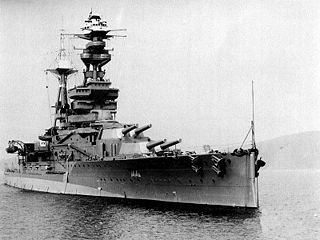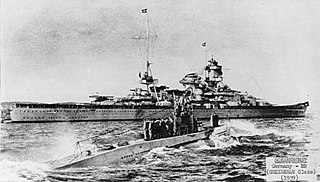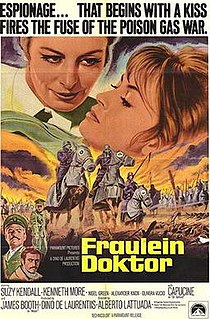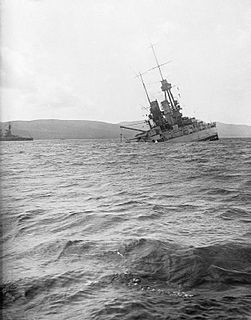See also
| This disambiguation page lists articles associated with the title Scapa Flow. If an internal link led you here, you may wish to change the link to point directly to the intended article. |
Scapa Flow is a body of water in the Orkney Islands.
Scapa Flow may also refer to:
| This disambiguation page lists articles associated with the title Scapa Flow. If an internal link led you here, you may wish to change the link to point directly to the intended article. |

HMS Hampshire was one of six Devonshire-class armoured cruisers built for the Royal Navy in the first decade of the 20th century. She was assigned to the 1st Cruiser Squadron of the Channel Fleet upon completion. After a refit, she was assigned to the reserve Third Fleet in 1909 before going to the Mediterranean Fleet in 1911. She was transferred to the China Station in 1912 and remained there until the start of the First World War in August 1914.

Scapa Flow is a body of water in the Orkney Islands, Scotland, sheltered by the islands of Mainland, Graemsay, Burray, South Ronaldsay and Hoy. Its sheltered waters have played an important role in travel, trade and conflict throughout the centuries. Vikings anchored their longships in Scapa Flow more than a thousand years ago. It was the United Kingdom's chief naval base during the First and Second World Wars, but the facility was closed in 1956.

Burray is one of the Orkney Islands in Scotland. It lies to the east of Scapa Flow and is one of a chain of islands linked by the Churchill Barriers.

HMS Royal Oak was one of five Revenge-class battleships built for the Royal Navy during the First World War. Completed in 1916, the ship first saw combat at the Battle of Jutland as part of the Grand Fleet. In peacetime, she served in the Atlantic, Home and Mediterranean fleets, more than once coming under accidental attack. Royal Oak drew worldwide attention in 1928 when her senior officers were controversially court-martialled, an event which brought considerable embarrassment to the world's then largest navy. Attempts to modernise Royal Oak throughout her 25-year career could not fix her fundamental lack of speed and, by the start of the Second World War, she was no longer suitable for front-line duty.

HMS Iron Duke was a dreadnought battleship of the Royal Navy, the lead ship of her class, named in honour of Arthur Wellesley, 1st Duke of Wellington. She was built by Portsmouth Dockyard, and her keel laid in January 1912. Launched ten months later, she was commissioned into the Home Fleet in March 1914 as the fleet flagship. She was armed with a main battery of ten 13.5-inch (340 mm) guns and was capable of a top speed of 21.25 knots.

HMS Vanguard was one of three St Vincent-class dreadnought battleships built for the Royal Navy in the first decade of the 20th century. She spent her career assigned to the Home and Grand Fleets. Aside from participating in the Battle of Jutland in May 1916 and the inconclusive Action of 19 August several months later, her service during World War I mostly consisted of routine patrols and training in the North Sea.

German submarine U-47 was a Type VIIB U-boat of Nazi Germany's navy (Kriegsmarine) during World War II. She was laid down on 25 February 1937 at Friedrich Krupp Germaniawerft in Kiel as yard number 582 and went into service on 17 December 1938 under the command of Günther Prien.
Scapa Flow was a Swedish EBM band, formed in 1988, and was one of the icons of the new EBM and synth scene that sprung up in Sweden in the late 80's. They toured frequently in Sweden and made a German tour in 1991 with fellow Swedish EBM´ers Pouppée Fabrikk.
Gutter Sound is a location in Orkney, Scotland, part of the vast anchorage of Scapa Flow. It lies to the west of the main harbour between the internal islands of Cava and Fara, and the large outer island of Hoy. Gutter Sound was the one of the sites of the mass-scuttling of the interned Imperial German High Seas Fleet in 1919, and the scene of a major salvage operation in the 1920s. Today the remaining wrecks make the Sound a popular diving location.
Hans Hermann Ludwig von Reuter was a German admiral who commanded the High Seas Fleet when it was interned at Scapa Flow in the north of Scotland at the end of World War I. On 21 June 1919 he ordered the scuttling of the German fleet in Scapa Flow to prevent the British from seizing the ships.

USS Capps (DD-550), a Fletcher-class destroyer, was a ship of the United States Navy named for Rear Admiral Washington L. Capps (1864–1935).

Divide and Conquer (1943) is the third film of Frank Capra's Why We Fight propaganda film series, dealing with the Nazi conquest of Western Europe in 1940.

Operation Dervish was the first of the Arctic Convoys of the Second World War by which the Western Allies supplied material to the Soviet Union in its fight with Nazi Germany. Included in the convoy was the personnel and equipment of an RAF Wing, for the air defence of the Russian ports, and several civilians and diplomatic missions.

Fräulein Doktor is a 1969 spy film loosely based on the life of Elsbeth Schragmüller. It was an Italian and Yugoslavian co-production directed by Alberto Lattuada, starring Suzy Kendall and Kenneth More, and featuring Capucine, James Booth, Giancarlo Giannini and Nigel Green. It was produced by Dino De Laurentiis and has a music score by Ennio Morricone. It was distributed by Paramount Pictures in the United States.

Lyness is a village on the east coast of the island of Hoy, Orkney, Scotland. The village is within the parish of Walls and Flotta, and is situated at the junction of the B9047 and B9048.

The scuttling of the German fleet took place at the Royal Navy's base at Scapa Flow, in the Orkney Islands of Scotland, shortly after the First World War. The High Seas Fleet was interned there under the terms of the Armistice whilst negotiations took place over the fate of the ships. Fearing that all of the ships would be seized and divided amongst the Allies, Admiral Ludwig von Reuter decided to scuttle the fleet.

HMS Martin was an M-class destroyer of the Royal Navy, launched at the Tyneside yard of Vickers-Armstrongs on 12 December 1940. She had a busy but brief wartime career, being sunk by the German submarine U-431 on 10 November 1942 off Algiers.
Scapa Flow (1924–1928) was an American Thoroughbred race horse, a son of Man o' War. He first came to prominence in 1926 after winning the 43rd running of the United States Hotel Stakes as a two-year-old. He was owned by Mr. and Mrs. Walter M. Jeffords, who bred him. In August 1926, Morton Schwartz offered $100,000 to purchase Scapa Flow, but his owners refused to sell him at any price.
Scapa Flow is a 1930 German drama film directed by Leo Lasko and starring Otto Gebühr, Claire Rommer and Claus Clausen. It is set around the Wilhelmshaven Mutiny and the Scuttling of the German fleet in Scapa Flow at the close of the First World War. In Weimar Germany the scuttling of the fleet in defiance of the victorious Allies had come to be seen as a popular patriotic act. The inclusion of the Mutiny, however, was more controversial as it highlighted the political divisions which continued to exist. The film was praised by the right wing press, and comparisons were made to the Russian film Battleship Potemkin. The film was partly inspired by the 1918 play Seeschalt by Reinhardt Goering.

SMS G102 was a German Torpedo boat that was sunk as a target by US army S.E.5 aircraft in the Atlantic Ocean off Cape Henry, Virginia, United States on 13 July 1921 after having been salvaged as war reparations following her failed scuttling in Scapa Flow two years prior.